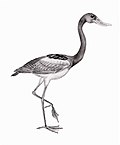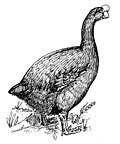| Anachronornis Temporal range: Latest Paleocene, | |
|---|---|
| Scientific classification | |
| Domain: | Eukaryota |
| Kingdom: | Animalia |
| Phylum: | Chordata |
| Class: | Aves |
| Order: | Anseriformes |
| Family: | † Anachronornithidae Houde, Dickson, & Camarena, 2023 |
| Genus: | † Anachronornis Houde, Dickson, & Camarena, 2023 |
| Species: | †A. anhimops |
| Binomial name | |
| †Anachronornis anhimops Houde, Dickson, & Camarena, 2023 | |
Anachronornis is a genus of extinct bird from the Late Paleocene (Thanetian) of North America. One species has been described, Anachronornis anhimops, from the Willwood Formation in Wyoming. It is a basal anseriform, relative of modern waterfowl. [1]

